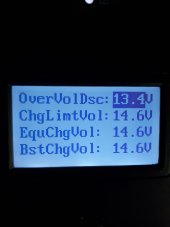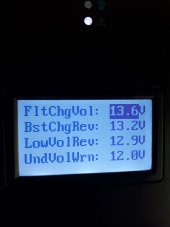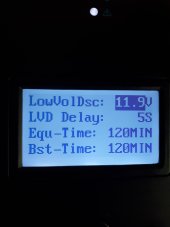Equalise volts, same as boost volts, 14.0
Boost volts, 14.0
Float volts, 13.4
Boost charge return volts, 13.2
Boost duration, 30 minutes
Equalise duration, 10 minutes ( setting to zero can confuse)
Temperature compensation off
Equilisation period, set to 0 days, this should disable the function
Most of the other settings relate to the load outputs of controller and do not Influence charging.
With the BMS, keep the default protection values as supplied by Overkill. Regard the BMS as a last resort, and configure chargers and load control to be 'inside' the BMS protection envelope.
Attempting to maintain battery SOC, 20 to 90% is slightly difficult to achieve and for maximum SOC perhaps undesirable.
It's only charging values that effect the high SOC. You need to consider cell balancing, this only takes at high charge volts, over 3.4 per cell, 13.6 per battery, and since cell Inbalance will only show up when the cells are in a high state of charge , the charge volts need to be high enough to achieve this . The suggested charge volts of 14.0 with a modest absorption period is a low stress charge process but high enough for cell balance to occur. The suggested float volts of 13.4 is battery resting volts at below maximum capacity further reducing battery stress.
The discharge limit level at 20% SOC can be achieved by detecting battery volts and taking action. 20% corresponds to a battery volts of 12 to 12.5 depending on loads, heavy loads may cause greater 'sag'. The actual voltage could be determined with experience of how the battery responds to system loads. The limit could be programmed Into the low volts disconnect of an inverter, or
a device like the Victron battery protect could be used to disconnect the loads, ( but not an inverter directly), or
you have the load interface , programmable, on the Renogy controller, so this can be used to disconnect the loads via suitable electronics.
You need to ignore the SOC reading given by the Renogy charger. It's totally inaccurate .
Mike







